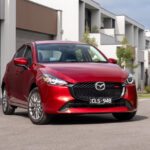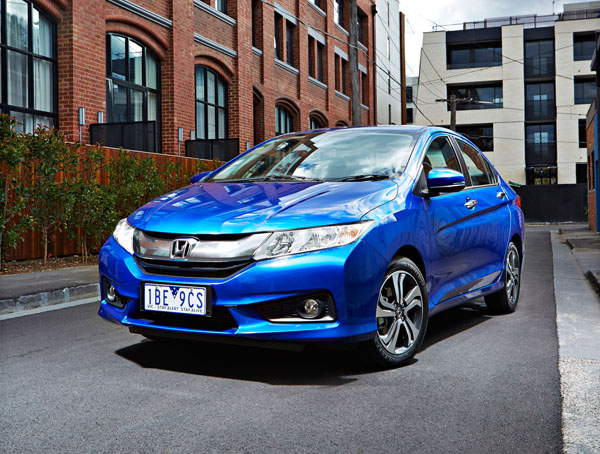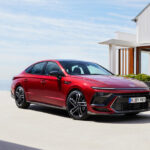
The good folks at BMW just couldn’t help themselves. Their i3 electric city car is clearly their vision of the future … but BMW has a long history of sporting motoring. So the i3 engineers and stylists couldn’t resist designing a sports version, tagged, without a great deal of imagination, the i3s.
We reckon there’s a strong chance that the engineers from the BMW i8 supercar section of the i Division had a finger in the pie as well. And we wonder if the revheads from M Division called in to say g’day from time to time?
We’ve just spent an enjoyable week in a BMW i3s and found it even more fun to drive than the standard i3 94ah we had a few months back.
STYLING
Cute and very different inside and out, BMW i3 is basically a large volume rectangular box that’s been rounded off at the edges and corners to add some style. The result is cabin spaciousness you don’t get in conventional cars of this size.
The i3s front spoiler is wider and bolder in its shape than the standard i3. The rear track is widened by 40mm because it has wheelarch surrounds added to cover the extra width of the wheels. The black colour of these surrounds is continued onto the door sills, and the 20-inch alloy wheels are in black. Sporty? Well sort of, but we certainly liked the appearance.
POWERTRAIN
Power and torque from the electric motor have both been increased. Power to 135 kW (it was 125 kW), torque to 270 Nm (250 Nm). These are the sort of numbers you would expect from a six-cylinder petrol engine of about 3.0 litres, so there’s plenty of grunt in this little Bimmer.
There’s the option of a range extender engine, a small twin-cylinder petrol unit. It never powers the i3s directly but only maintains the battery charge at its current level, it doesn’t increase the amount of energy in the batteries, simply adds to the overall range of the vehicle. It was fitted to our road test car.
DRIVING
Performance is terrific, with the instant off-the-line reaction we love in all electric cars. There’s near silence from the rear mounted electric motor and the little petrol charging engine is barely audible when it spins away at its fixed speed.
Most of our driving was done in Comfort mode rather than in one of Eco modes. That’s because this is a sporty model and surely that’s the way the typical owner would drive one.
Around town a range of 190 to 225 kilometres was possible in Comfort mode. Which is more than enough for normal suburban daily use.
Motorway driving, still in Comfort mode gave an electric-only range of about 170 to 180 km. Enough to get from the Gold Coast to Brisbane and back again.
The BMW i3 can be a ‘one-pedal’ car, as you can use the pedal on the right to increase and decrease speed. Indeed everyone we have spoken to about electric cars says they enjoy the challenge of not having to use the brake pedal.
In the i3s we were able to make virtually all trips around town without using the brakes. The biggest plus of electric and hybrid vehicles is that energy is put back into the batteries when slowing down or descending a hill. There were times when we finished shortish downhill trips with more range than when we started. That brings a smile to the face!
Tyres are 20mm wider than in the standard i3 and sit around 20-inch rims. Suspension changes in the i3s include a 10mm lower ride height, firmer springs and anti-roll bar and dampers.
Ride comfort is generally good but isn’t a strong feature of the i3 range. In the i3s it’s firmer again and big bumps and dips can cause the suspension to crash at times.
Road grip is fine, but frankly it doesn’t feel like a sports model. The steering feel remains on the the dead side and there’s nothing like the feedback you get on even the lowest cost conventional BMWs.
Using the Sport mode changes throttle response, which is great. It also changes the steering feel, but we still wanted more.
The battery-only BMW i3s is priced at $69,900, with the range-extender adding $6000. Given the significantly increased range we wouldn’t be surprised if some buyers opt for the battery only model. Less money, more performance as it is lighter, plus longer range are all appealing features.
The battery pack is designed to last for the life of the car and is covered by an eight-year or 100,000km battery warranty.
SUMMING UP
The sheer joy of life provided by the instant acceleration of the BMW i3s is its biggest attraction. But we are not sure it really qualifies as a sports model that will have you getting your out of bed early on a Sunday morning to head for the the hills.
CHARGING
Part of all our road testing program of electric and plugin hybrid vehicles is to take them to our local shopping centre at Pacific Fair on the Gold Coast.
When we rolled up we discovered the ChargePoint charging cables wouldn’t fit into our car. A phone call to the BMW i3 specialist told us the i3s is using the latest Type 2 technology that’s common in Europe. Standard i3 models in Australia use Type 1 units.
Adapters to use the Type 1 cables are available at a cost of about $300, but BMW hasn’t tested these and therefore could not recommend them.
ChargePoint tells us it has heard of no problems with adaptors and that it will have Type 2 chargers join Type 1 within a few weeks, probably by mid July.
A call to the EV Council of Australia led to a somewhat frustrated specialist talking about the lack of interest at all levels of the Australian government on electric cars.
I too, have written about this government inaction on many occasions – but still nothing has happened. And our governments like to boast that Australia is a high-tech country…
AT A GLANCE
MODEL RANGE
i3: $68,700 (automatic)
i3 Rex: $74,700 (automatic)
i3s: $69,900 (automatic)
i3s Rex: $75,900 (automatic)
Note: These prices do not include government or dealer delivery charges. Contact your local BMW dealer for drive-away prices.
SPECIFICATIONS (BMW i3s Rex)
ENGINE:
Capacity: NA
Configuration: NA
Maximum Power: 135 kW @ NA rpm
Maximum Torque: 270 Nm @ NA rpm
Fuel Type: Premium unleaded petrol
Combined Fuel Cycle (ADR 81/02): 0.6 L/100km
CO2 Emissions: 13 g/km
DRIVELINE: One speed automatic
DIMENSIONS, WEIGHT AND CAPACITIES:
Length: 3999 mm
Wheelbase: 2570 mm
Width: 1775 mm
Height: 1578 mm
Turning Circle: 9.9 metres
Kerb Mass: 1365 kg
Fuel Tank Capacity: 9 litres
BRAKES:
Front: Ventilated disc
Rear: Solid disc
STANDARD WARRANTY:
Three years / unlimited kilometres













